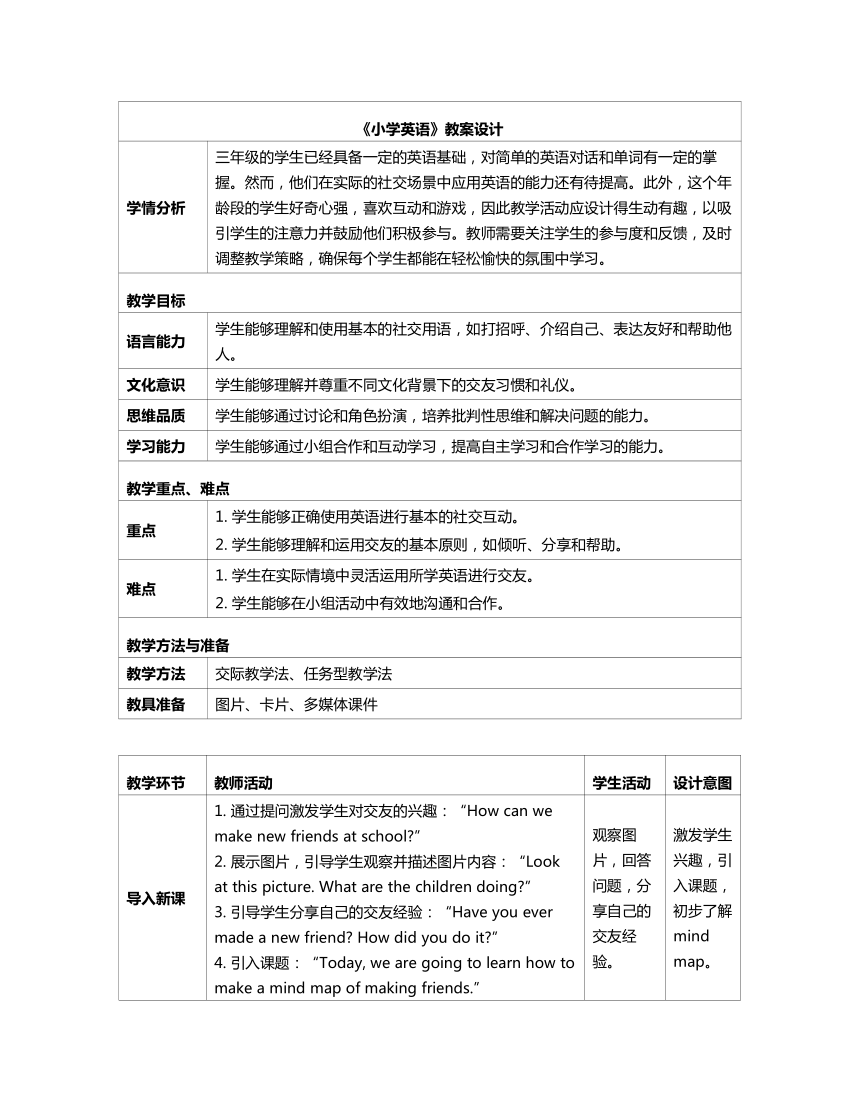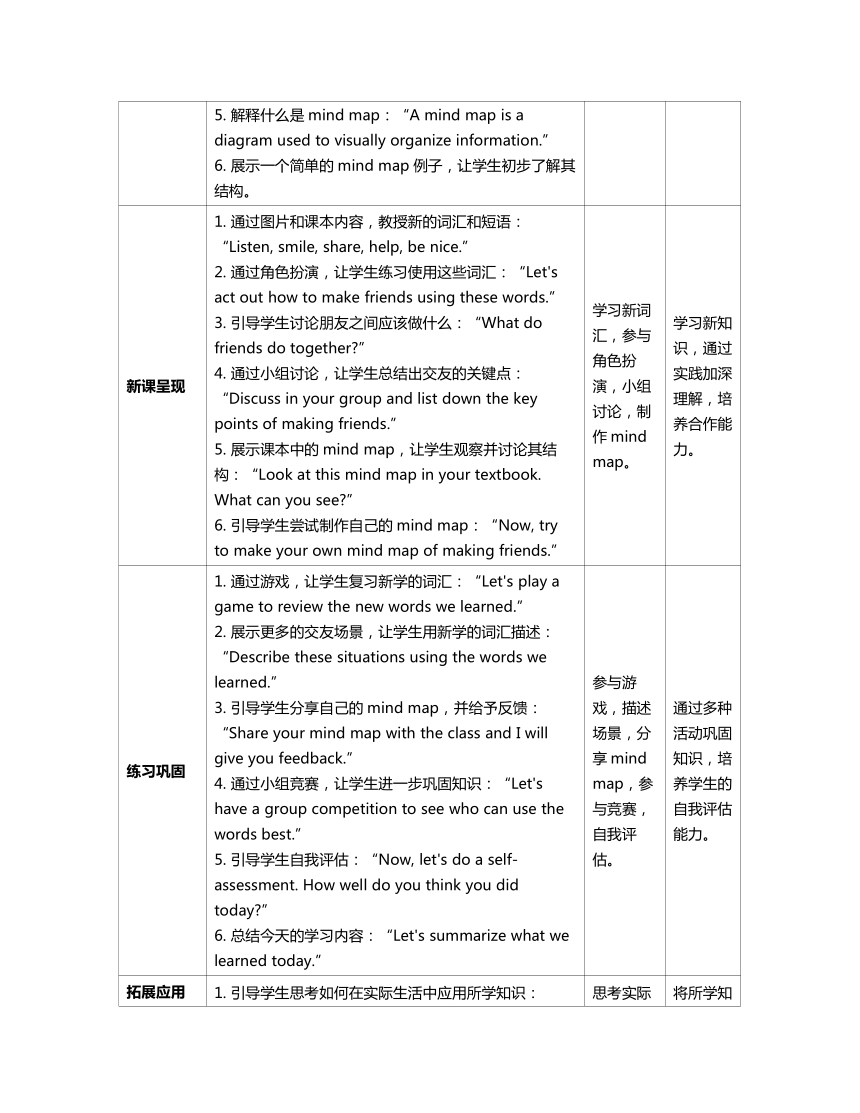Unit1 Making friends Part C Make a mind map of making friends 表格式教案设计
文档属性
| 名称 | Unit1 Making friends Part C Make a mind map of making friends 表格式教案设计 |  | |
| 格式 | docx | ||
| 文件大小 | 21.0KB | ||
| 资源类型 | 教案 | ||
| 版本资源 | 人教版(PEP) | ||
| 科目 | 英语 | ||
| 更新时间 | 2024-09-19 13:57:11 | ||
图片预览


文档简介
《小学英语》教案设计
学情分析 三年级的学生已经具备一定的英语基础,对简单的英语对话和单词有一定的掌握。然而,他们在实际的社交场景中应用英语的能力还有待提高。此外,这个年龄段的学生好奇心强,喜欢互动和游戏,因此教学活动应设计得生动有趣,以吸引学生的注意力并鼓励他们积极参与。教师需要关注学生的参与度和反馈,及时调整教学策略,确保每个学生都能在轻松愉快的氛围中学习。
教学目标
语言能力 学生能够理解和使用基本的社交用语,如打招呼、介绍自己、表达友好和帮助他人。
文化意识 学生能够理解并尊重不同文化背景下的交友习惯和礼仪。
思维品质 学生能够通过讨论和角色扮演,培养批判性思维和解决问题的能力。
学习能力 学生能够通过小组合作和互动学习,提高自主学习和合作学习的能力。
教学重点、难点
重点 1. 学生能够正确使用英语进行基本的社交互动。 2. 学生能够理解和运用交友的基本原则,如倾听、分享和帮助。
难点 1. 学生在实际情境中灵活运用所学英语进行交友。 2. 学生能够在小组活动中有效地沟通和合作。
教学方法与准备
教学方法 交际教学法、任务型教学法
教具准备 图片、卡片、多媒体课件
教学环节 教师活动 学生活动 设计意图
导入新课 1. 通过提问激发学生对交友的兴趣:“How can we make new friends at school ”
2. 展示图片,引导学生观察并描述图片内容:“Look at this picture. What are the children doing ”
3. 引导学生分享自己的交友经验:“Have you ever made a new friend How did you do it ”
4. 引入课题:“Today, we are going to learn how to make a mind map of making friends.”
5. 解释什么是mind map:“A mind map is a diagram used to visually organize information.”
6. 展示一个简单的mind map例子,让学生初步了解其结构。 观察图片,回答问题,分享自己的交友经验。 激发学生兴趣,引入课题,初步了解mind map。
新课呈现 1. 通过图片和课本内容,教授新的词汇和短语:“Listen, smile, share, help, be nice.”
2. 通过角色扮演,让学生练习使用这些词汇:“Let's act out how to make friends using these words.”
3. 引导学生讨论朋友之间应该做什么:“What do friends do together ”
4. 通过小组讨论,让学生总结出交友的关键点:“Discuss in your group and list down the key points of making friends.”
5. 展示课本中的mind map,让学生观察并讨论其结构:“Look at this mind map in your textbook. What can you see ”
6. 引导学生尝试制作自己的mind map:“Now, try to make your own mind map of making friends.” 学习新词汇,参与角色扮演,小组讨论,制作mind map。 学习新知识,通过实践加深理解,培养合作能力。
练习巩固 1. 通过游戏,让学生复习新学的词汇:“Let's play a game to review the new words we learned.”
2. 展示更多的交友场景,让学生用新学的词汇描述:“Describe these situations using the words we learned.”
3. 引导学生分享自己的mind map,并给予反馈:“Share your mind map with the class and I will give you feedback.”
4. 通过小组竞赛,让学生进一步巩固知识:“Let's have a group competition to see who can use the words best.”
5. 引导学生自我评估:“Now, let's do a self-assessment. How well do you think you did today ”
6. 总结今天的学习内容:“Let's summarize what we learned today.” 参与游戏,描述场景,分享mind map,参与竞赛,自我评估。 通过多种活动巩固知识,培养学生的自我评估能力。
拓展应用 1. 引导学生思考如何在实际生活中应用所学知识:“How can you use what you learned today in real life ”
2. 通过角色扮演,让学生模拟实际交友场景:“Let's act out a real-life situation where you make a new friend.”
3. 引导学生讨论如何在不同情境下交友:“What if you are in a new school How can you make friends ”
4. 通过小组讨论,让学生提出实际可行的交友策略:“Discuss in your group and come up with practical strategies for making friends.”
5. 引导学生反思今天的学习:“What did you learn today that you think is most useful ”
6. 布置家庭作业:“For homework, I want you to practice making a new friend and write about your experience.” 思考实际应用,参与角色扮演,小组讨论,反思学习,完成作业。 将所学知识应用到实际生活中,培养学生的实际操作能力。
总结反馈 1. 总结今天的学习内容:“Let's summarize what we learned today.”
2. 引导学生分享今天的学习感受:“How do you feel about today's lesson ”
3. 给予学生正面的反馈和鼓励:“I am very proud of your hard work today. Keep it up!”
4. 引导学生提出对课程的建议:“Do you have any suggestions for how we can improve our lessons ”
5. 提醒学生完成家庭作业:“Don't forget to do your homework tonight.”
6. 结束课程:“That's all for today. Have a great day!” 总结学习内容,分享感受,提出建议。 总结学习,培养学生的反思和建议能力。
家庭作业 1. 布置具体的家庭作业任务:“For homework, I want you to practice making a new friend and write about your experience.”
2. 解释作业要求:“Write about how you met the new friend, what you did together, and how you felt.”
3. 提醒学生注意作业的细节:“Make sure to include details about your interaction and feelings.”
4. 鼓励学生积极参与:“I am looking forward to reading your stories.”
5. 提醒学生作业提交时间:“Please submit your homework by next class.”
6. 结束语:“Have fun making new friends and writing about it!” 完成家庭作业,写交友经历。 通过家庭作业巩固课堂知识,培养学生的实际操作能力。
课后反思 1. 教师自我反思今天的教学:“What went well today What could be improved ”
2. 思考如何改进教学方法:“How can I make the lessons more engaging and effective ”
3. 记录学生的表现和反馈:“What were the students' reactions and feedback ”
4. 制定改进计划:“What changes should I make for the next lesson ”
5. 准备下一课的教案:“What should I include in the next lesson plan ”
6. 结束反思:“I am looking forward to implementing these changes in the next lesson.” 无 通过反思提高教学质量,为下一课做好准备。
作业设计
基础练习 1. 根据课堂上的mind map,画出你自己的朋友关系图,并标注你和朋友之间的互动方式。 2. 写下至少三种你可以用来交新朋友的方式,并举例说明。
拓展练习 1. 准备一段简短的自我介绍,包括你的名字、爱好和为什么想交新朋友。 2. 观察并记录你本周内与同学的互动,评估你是否有效地使用了课堂上学到的交友技巧。
板书设计
Making Friends Mind Map Greet: "Hi!" Smile Listen Share Be nice Help Play together
教学反思
成功之处 1. 通过mind map的制作,学生能够直观地理解和记忆交友的技巧。 2. 课堂互动频繁,学生积极参与,有效提高了课堂参与度。
不足之处 1. 部分学生在分享环节表现较为害羞,需要进一步鼓励和引导。 2. 板书设计可以更加生动有趣,以吸引学生的注意力。
学情分析 三年级的学生已经具备一定的英语基础,对简单的英语对话和单词有一定的掌握。然而,他们在实际的社交场景中应用英语的能力还有待提高。此外,这个年龄段的学生好奇心强,喜欢互动和游戏,因此教学活动应设计得生动有趣,以吸引学生的注意力并鼓励他们积极参与。教师需要关注学生的参与度和反馈,及时调整教学策略,确保每个学生都能在轻松愉快的氛围中学习。
教学目标
语言能力 学生能够理解和使用基本的社交用语,如打招呼、介绍自己、表达友好和帮助他人。
文化意识 学生能够理解并尊重不同文化背景下的交友习惯和礼仪。
思维品质 学生能够通过讨论和角色扮演,培养批判性思维和解决问题的能力。
学习能力 学生能够通过小组合作和互动学习,提高自主学习和合作学习的能力。
教学重点、难点
重点 1. 学生能够正确使用英语进行基本的社交互动。 2. 学生能够理解和运用交友的基本原则,如倾听、分享和帮助。
难点 1. 学生在实际情境中灵活运用所学英语进行交友。 2. 学生能够在小组活动中有效地沟通和合作。
教学方法与准备
教学方法 交际教学法、任务型教学法
教具准备 图片、卡片、多媒体课件
教学环节 教师活动 学生活动 设计意图
导入新课 1. 通过提问激发学生对交友的兴趣:“How can we make new friends at school ”
2. 展示图片,引导学生观察并描述图片内容:“Look at this picture. What are the children doing ”
3. 引导学生分享自己的交友经验:“Have you ever made a new friend How did you do it ”
4. 引入课题:“Today, we are going to learn how to make a mind map of making friends.”
5. 解释什么是mind map:“A mind map is a diagram used to visually organize information.”
6. 展示一个简单的mind map例子,让学生初步了解其结构。 观察图片,回答问题,分享自己的交友经验。 激发学生兴趣,引入课题,初步了解mind map。
新课呈现 1. 通过图片和课本内容,教授新的词汇和短语:“Listen, smile, share, help, be nice.”
2. 通过角色扮演,让学生练习使用这些词汇:“Let's act out how to make friends using these words.”
3. 引导学生讨论朋友之间应该做什么:“What do friends do together ”
4. 通过小组讨论,让学生总结出交友的关键点:“Discuss in your group and list down the key points of making friends.”
5. 展示课本中的mind map,让学生观察并讨论其结构:“Look at this mind map in your textbook. What can you see ”
6. 引导学生尝试制作自己的mind map:“Now, try to make your own mind map of making friends.” 学习新词汇,参与角色扮演,小组讨论,制作mind map。 学习新知识,通过实践加深理解,培养合作能力。
练习巩固 1. 通过游戏,让学生复习新学的词汇:“Let's play a game to review the new words we learned.”
2. 展示更多的交友场景,让学生用新学的词汇描述:“Describe these situations using the words we learned.”
3. 引导学生分享自己的mind map,并给予反馈:“Share your mind map with the class and I will give you feedback.”
4. 通过小组竞赛,让学生进一步巩固知识:“Let's have a group competition to see who can use the words best.”
5. 引导学生自我评估:“Now, let's do a self-assessment. How well do you think you did today ”
6. 总结今天的学习内容:“Let's summarize what we learned today.” 参与游戏,描述场景,分享mind map,参与竞赛,自我评估。 通过多种活动巩固知识,培养学生的自我评估能力。
拓展应用 1. 引导学生思考如何在实际生活中应用所学知识:“How can you use what you learned today in real life ”
2. 通过角色扮演,让学生模拟实际交友场景:“Let's act out a real-life situation where you make a new friend.”
3. 引导学生讨论如何在不同情境下交友:“What if you are in a new school How can you make friends ”
4. 通过小组讨论,让学生提出实际可行的交友策略:“Discuss in your group and come up with practical strategies for making friends.”
5. 引导学生反思今天的学习:“What did you learn today that you think is most useful ”
6. 布置家庭作业:“For homework, I want you to practice making a new friend and write about your experience.” 思考实际应用,参与角色扮演,小组讨论,反思学习,完成作业。 将所学知识应用到实际生活中,培养学生的实际操作能力。
总结反馈 1. 总结今天的学习内容:“Let's summarize what we learned today.”
2. 引导学生分享今天的学习感受:“How do you feel about today's lesson ”
3. 给予学生正面的反馈和鼓励:“I am very proud of your hard work today. Keep it up!”
4. 引导学生提出对课程的建议:“Do you have any suggestions for how we can improve our lessons ”
5. 提醒学生完成家庭作业:“Don't forget to do your homework tonight.”
6. 结束课程:“That's all for today. Have a great day!” 总结学习内容,分享感受,提出建议。 总结学习,培养学生的反思和建议能力。
家庭作业 1. 布置具体的家庭作业任务:“For homework, I want you to practice making a new friend and write about your experience.”
2. 解释作业要求:“Write about how you met the new friend, what you did together, and how you felt.”
3. 提醒学生注意作业的细节:“Make sure to include details about your interaction and feelings.”
4. 鼓励学生积极参与:“I am looking forward to reading your stories.”
5. 提醒学生作业提交时间:“Please submit your homework by next class.”
6. 结束语:“Have fun making new friends and writing about it!” 完成家庭作业,写交友经历。 通过家庭作业巩固课堂知识,培养学生的实际操作能力。
课后反思 1. 教师自我反思今天的教学:“What went well today What could be improved ”
2. 思考如何改进教学方法:“How can I make the lessons more engaging and effective ”
3. 记录学生的表现和反馈:“What were the students' reactions and feedback ”
4. 制定改进计划:“What changes should I make for the next lesson ”
5. 准备下一课的教案:“What should I include in the next lesson plan ”
6. 结束反思:“I am looking forward to implementing these changes in the next lesson.” 无 通过反思提高教学质量,为下一课做好准备。
作业设计
基础练习 1. 根据课堂上的mind map,画出你自己的朋友关系图,并标注你和朋友之间的互动方式。 2. 写下至少三种你可以用来交新朋友的方式,并举例说明。
拓展练习 1. 准备一段简短的自我介绍,包括你的名字、爱好和为什么想交新朋友。 2. 观察并记录你本周内与同学的互动,评估你是否有效地使用了课堂上学到的交友技巧。
板书设计
Making Friends Mind Map Greet: "Hi!" Smile Listen Share Be nice Help Play together
教学反思
成功之处 1. 通过mind map的制作,学生能够直观地理解和记忆交友的技巧。 2. 课堂互动频繁,学生积极参与,有效提高了课堂参与度。
不足之处 1. 部分学生在分享环节表现较为害羞,需要进一步鼓励和引导。 2. 板书设计可以更加生动有趣,以吸引学生的注意力。
同课章节目录
